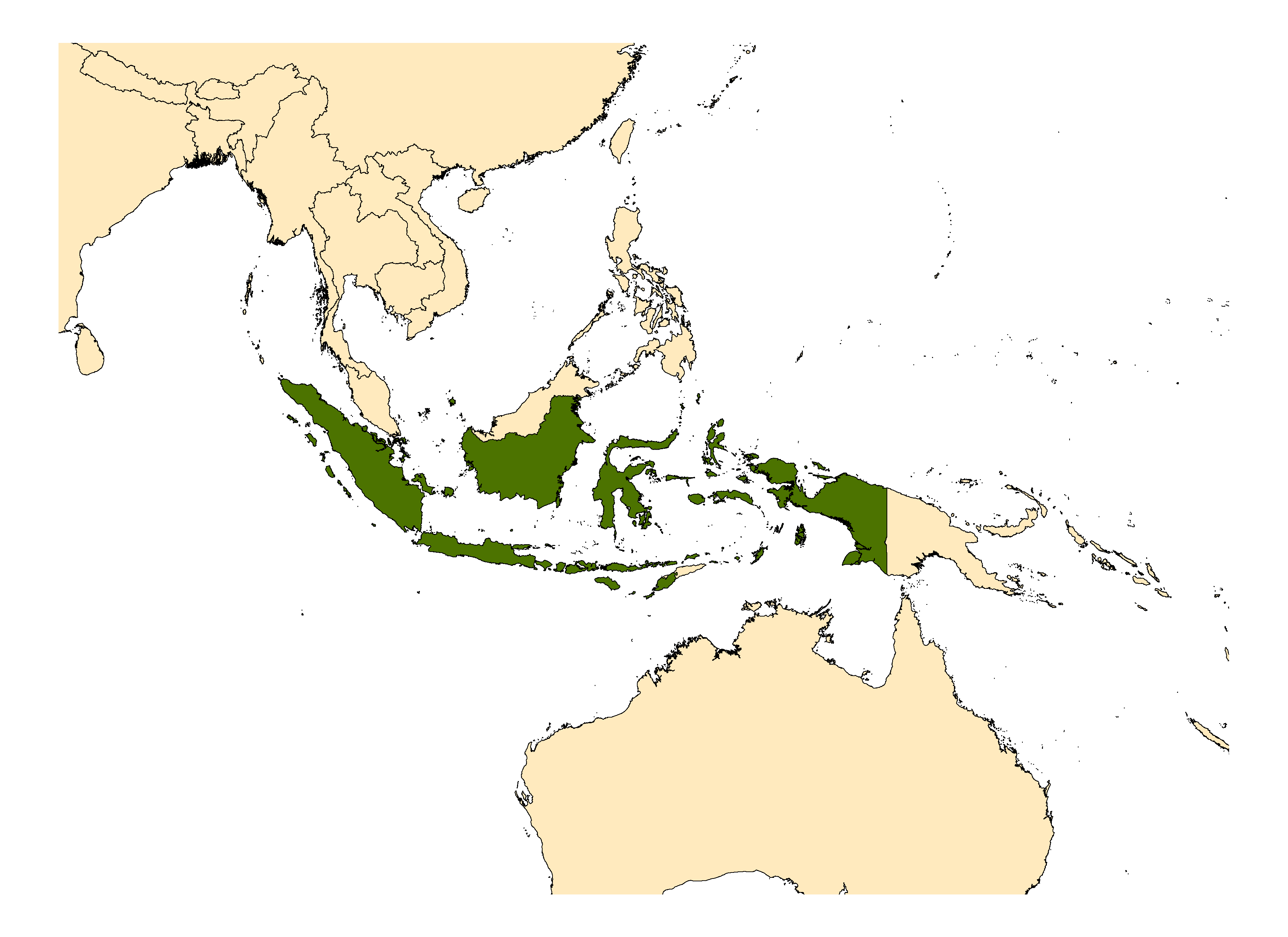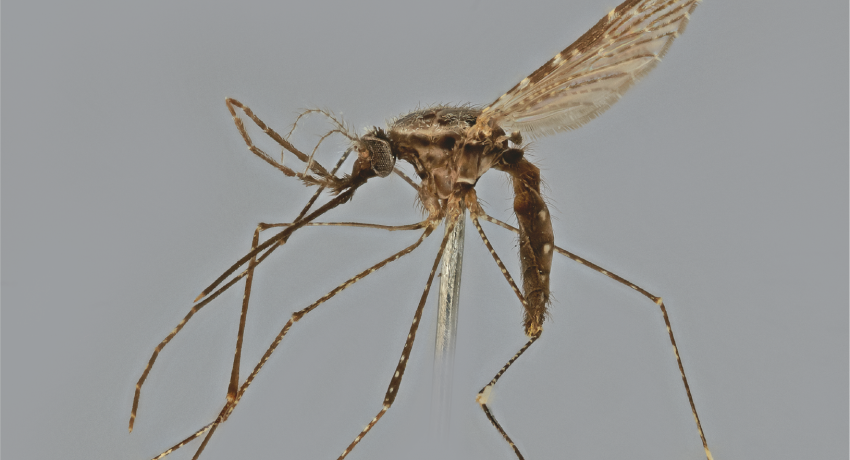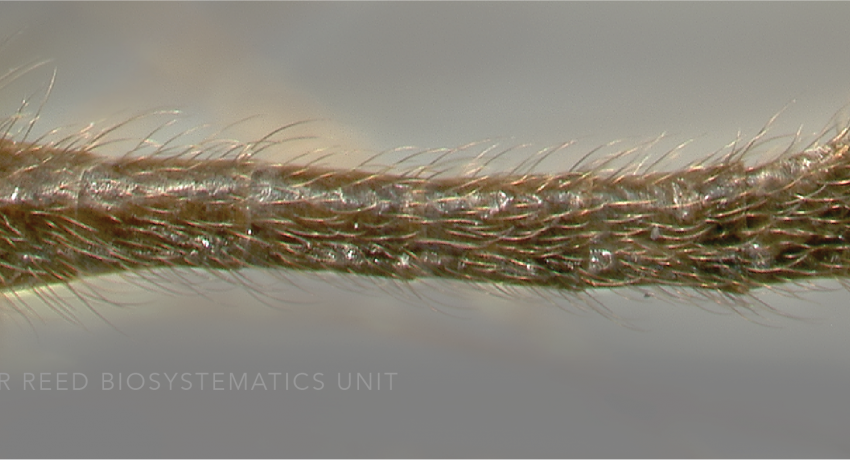ORIENTAL REGION
Etymology: Sulawesi, Indonesia
Anopheles sulawesi of the Leucosphyrus Subgroup (Neomyzomyia Series) is a Sulawesian endemic—found only on Sulawesi and some small adjacent islands, including Boeton, Kaboena, Sangihe and Talaud. The combination of a long proboscis (c. 1.25 x forefemur) and shorter palps (0.85–1.15 x forefemur) in An. sulawesi are shared with An. elegans (James), An. hackeri Edwards, and An. pujutensis Colless (also Leucosphyrus Subgroup) and differentiates these species from all other anophelines in the Oriental region. Anopheles sulawesi is rcognized by the presence of 1–4 spots in the presector dark spot on vein R—absent in An. hackeri and An. pujutensis. Anopheles sulawesi larvae are also distinctive in the length and placement of seta 4-C.
Type locality: Bone-Dumonga Forest Reserve, Toraut, Sulawesi
Type depository: U.S. National Museum, Washington, D.C., United States (USNM)
DIAGNOSTIC CHARACTERS (Click photos to view; mouse over and click large photo to zoom in.)
ADULT (illustrated): Head: Palpus with apical pale band c. 2x length of preapical dark band; MPlp5 mainly dark-scaled; proboscis mainly dark-scaled with band of pale scales at apex, basal to labella. Wings: Both M and M3+4 veins noticeably wavy; accessory sector pale spot absent from costa, present on vein R; presector dark spot on vein R with 1–4 pale interruptions; preapical dark spot of vein R1 with 1–4 pale spots; 6–10 pale interruptions from presector dark to preapical dark area of vein R1; sector dark spot of vein R1 with 2–5 pale spots. Legs: Ti-III apical pale band with narrow dark longitudinal extension on ventral surface in addition to separate dark spot; Ta-III2–5 without basal pale scales. Abdomen (dorsal): VIII-Te with posterior golden scales.
LARVA: Head: Seta 3-C single, extending beyond head margin; seta 4-C long, extending well beyond base of 2-C; seta 5-C conspicuously longer than antenna. Thorax: Seta 1-M basal sclerotized tubercle without a distinct pointed or angular tooth; seta 1-P basal sclerotized tubercle with prominent tooth on posterodorsal margin. Abdominal segments: Seta 1-II not fully developed palmate; individual leaflets of palmate setae with long and slender apical filaments; tergal plate on segments IV,V about 2x wider than deep, accessory plates usually absent.
TAXONOMIC KEYS
None
![]()
WRBU - Genera - Global - Larva
![]()
WRBU - Genera - Indomalaya - Adult
![]()
WRBU - Genera - Indomalaya - Larva
![]()
WRBU - Anopheles Subgenera and Series - Indomalaya - Adult
![]()
WRBU - Anopheles Subgenera and Series - Indomalaya - Larva
![]()
WRBU - Anopheles (Cel.) Neomyzomyia Series - Indomalaya - Adult
![]()
WRBU - Anopheles (Cel.) Neomyzomyia Series - Indomalaya - Larva
![]()
WRBU - Anopheles (Cel.) Neomyzomyia Series - Oriental - Adult
![]()
WRBU - Anopheles (Cel.) Neomyzomyia Series - Oriental - Larva
Exemplar DNA sequences
An. sulawesi COI: DQ897967
BIONOMICS
Immatures
Immature An. sulawesi have been collected from shaded rock pools, and in marginal pools overhung by vegetation and in drying river beds. Preferred habitats are typically lined with dead decaying leaf matter or thick black muddy soil substrates, and waters usually have a high organic content.
Adults
Anopheles sulawesi is the primary vector of malaria in Sulawesi. Little is known on the bionomics of the species, but two blood fed specimens in the U.S. National Collection bear labels indicating human feeding behavior; and another is labeled “Indoor-resting”. Surprisingly, a human landing collection conducted between 18:00 and 23:00 over three nights, only 3–5 m from the larval sites, reported no human landing captures of the species. This suggests either that the species either bite later in the night, perhaps that the newly emerged females fly away from the emergence sites before host seeking.
DISTRIBUTION NOTES
Indonesia (Sulawesi).

WRBU VECTOR HAZARD REPORTS
None; View other WRBU Vector Hazard Reports
Available GIS Models
None
IMPORTANT REFERENCES (full citations below)
Waktoedi Koesoemawinangoen 1954: 63 (A; as An. (Myzomyia) leuchosphyrus variety)
Colless 1956: 66 (F*; as leucosphyrus, Celebes form)
Reid 1968: 303 (F*; to species)
Hii et al. 1988: 43 (authorship change)
Sallum et al. 2005: 72 (M*, F*, P*, L*; neotype designation, corrected type locality)
Sallum et al. 2007: 30 (phylogeny)
CURRENT SYNONYMS
None
CITED REFERENCES
Colless, D.H. (1956). The Anopheles leucosphyrus group. Transactions of the Royal Entomological Society of London, 108, 37–116.
Hii, J.L.K., Peyton, E.L., & Shang, V.Y. (1988). Redescription of the adult and first description of the larva and pupa of Anopheles (Cellia) sulawesi Waktoedi, a species of the Leucosphyrus group from Sulawesi, Indonesia (Diptera, Culicidae). Mosquito Systematics, 20(1), 41–54.
Reid, J.A. (1968). Anopheline mosquitoes of Malaya and Borneo. Studies from the Institute for Medical Research Malaysia, 31, 1–520.
Sallum, M. A. M., Foster, P.G., Li, C., Sithiprasasna, R., & Wilkerson, R.C. (2007). Phylogeny of the Leucosphyrus Group of Anopheles (Cellia) (Diptera: Culicidae) based on mitochondrial gene sequences. Annals of the Entomological Society of America, 100(1), 27–35.
Sallum, M. A. M., Peyton, E.L., Harrison, B.A., & Wilkerson, R.C. (2005b). Revision of the Leucosphyrus Group of Anopheles (Cellia) (Diptera: Culicidae). Revista Brasileira de Entomología, 49(Suppl. 1), 1–152.
Waktoedi Koesoemawinangoen, R. (1954). Anophelini di Indonesia. Djilid I. Djakarta, Indonesia.
CITE THIS PAGE
Walter Reed Biosystematics Unit (Year). Anopheles sulawesi species page. Walter Reed Biosystematics Unit Website, http://wrbu.si.edu/vectorspecies/mosquitoes/sulawesi, accessed on [date (e.g. 03 February 2020) when you last viewed the site].











































































































































































